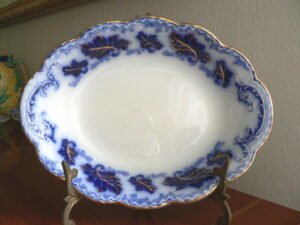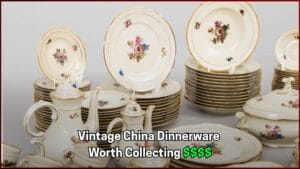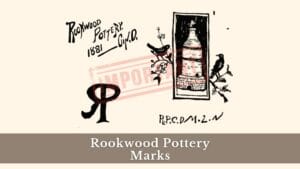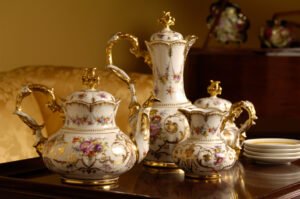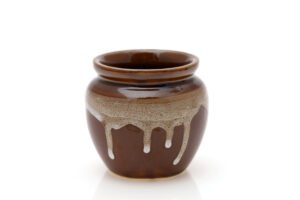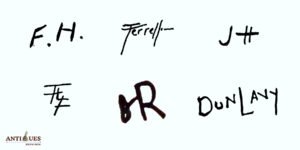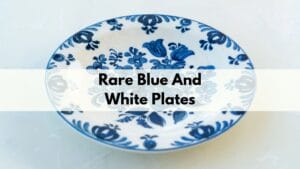If you have an old blue and white Flow Blue China porcelain dish in your kitchen’s crockery display, it could be worth as big a fortune as a rare Wedgewood single plate that sold for over $400!
But assessing how much is an old Flow Blue dish worth can be challenging if you don’t know what signs, patterns, and marks to look for! So, in this guide, I will help you identify real antique Flow Blue China by introducing you to its popular patterns, key features, and some important valuation factors!
A Glimpse at Flow Blue China’s History
Flow blue china is the iconic white earthenware (mostly transferware) pottery featuring a distinctive flowing or ‘bleeding blue pattern. It originated in the early 19th century in England’s popular English Staffordshire Potters area.
This pattern got its name, ‘flow blue, ‘ from its firing process, which involves applying a blue pigment to the pottery piece before glazing. The pigment bleeds or ‘flows’ all around the white clay or, occasionally, porcelain piece, giving it a unique flowing design!
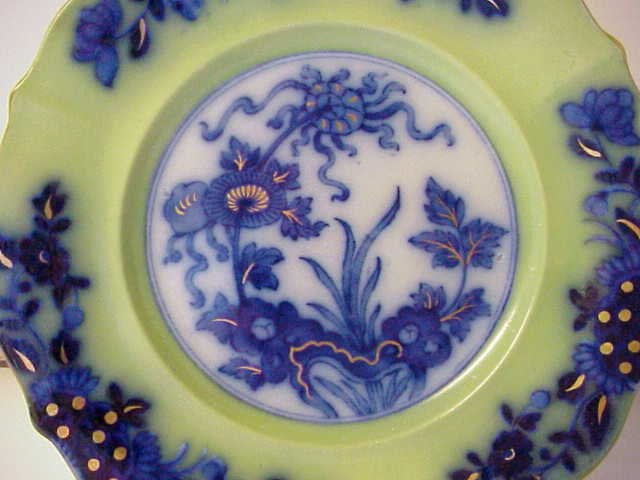
The pattern became popular in the States around the 1850s. After this, many pottery manufacturers in England and the United States began mass-producing the Flow Blue China ware, which became a common household item.
Popular throughout the early to late 1800s, the Flow Blue design saw a decline at the end of the 19th century. But even after going out of style, this distinctive pottery enjoys a prestigious desire as a popular collectible!
4 Factors That Affect the Worth of Flow Blue China (Value Guide)
Common antique Flow Blue china can be worth around $10 to $50 per piece and $50 to $100 per set, depending on the number of items. Individual items made by a renowned company or with a rare pattern can be worth up to $300 to $400.
To find the right price tag for a vintage Flow Blue ware piece, you must analyze the following factors!
- Condition: Flow Blue pieces in an undamaged condition without cracks, chipped edges, or dents are naturally more valuable than the damaged ones.
- The Rarity of the Pattern: Pieces with rare patterns that were produced in limited quantities or for a short period are more sought after and command premium prices. Common Flow Blue patterns, easily available in online markets or thrift stores, are worth less.
- Item Shape or Type: Common items like plates, platters, and bowls are more common and, hence, less valuable than Flow Blue teapots, sugar bowls, and creamers. These items were made in less quantity, making them rarer today!
- Manufacturer: A Flow Blue china piece made by a popular, renowned company, such as Wedgwood, John & George Alcock, Ridgway, and WH Grindley, will fetch higher returns than the one made by a less popular company.
- Age: Older Flow Blue ware from the early 19th century (1820s to 1850s), which is extremely hard to find today, is the most valuable. Later Victorian or Edwardian Flow Blue pieces may hold little monetary value.
How to Identify Flow Blue China (Markings & Other Features)
While there are several blue and white china products on the market, a few key features distinguish authentic Flow Blue china from the rest.
The Iconic Blue Color
Naturally, one of the most prominent features of the Flow Blue china is its unique bright blue color on the milky white china porcelain pottery.
While the blue pigment hue can change from a grayish-blue to vivid cobalt blue to dark navy or steel blue depending on different manufacturers, the pattern in all blue shades has a soft, watercolor-like, “flowing” appearance.
The “Flowing” & Blending of the Pigment
What really helps distinguish the Flow Blue pattern is its blurred, blended design that “flows” on the white-glazed china pieces. The blue pigment appears to bleed on the surface instead of making a solid, uniform design.
Besides, the authentic Flow Blue china is found to have proper shading with light and dark shades to add depth to the designs.

Most Valuable Flow Blue China Patterns (With Values)
Understanding the unique patterns on antique Flow Blue ware not only helps in identifying it but also helps in tracking its age and manufacturers. The earliest Flow Blue patterns released by English potters were influenced by Chinese porcelain and featured landscapes with pagodas, Willow trees, and temples.
The mid-Victorian Era saw the rise of highly elaborate pastoral and floral design elements on Flow Blue China. The makers also tried to display European culture by adding a touch of gold.
Starting in the mid-1880s, the late Victorian Era brought a change in material and style. Instead of ironstone, Flow Blue transferware used a lighter china material, and the patterns were influenced by Art Nouveau floral designs.
Among the several Flow Blue china patterns that emerged since the early 1800s, here are the most popular and valuable ones (with values) to look for:
1. “Scinde” by John & George Alcock (1840)
Design: A Blue Willow-style pattern featuring willow trees, floral motifs, and pagodas at the center and a floral scroll pattern on the edges.
Estimated Value: Being one of the earliest Flow Blue china patterns, the value of individual dishes with the Scinde pattern can range from $100 to $300, like this one I found on eBay that sold for $300!

2. “Edward Challinor Rock” (1845)
Design: An oriental design with flowers and a foliage scroll pattern on the edge and a central design with flora and fauna and temples.
Estimated Price: The Edward Challinor Rock Flow Blue china is worth around $10 to $50 for individual pieces, while full sets can sell for more.
3. “Manilla” by Podmore & Walker (1845)
Design: A landscape with Willow trees and palm trees surrounded by floral designs on the edges.
Estimated Value: The value of single Flow Blue China pieces with Manilla design can range from $20 to $40, while the sets can be worth $40 to $150 or more.
4. “Excelsior” by Tomas Fell (1850)
Design: A landscape with a river in the middle and Pagodas (temples) and large trees on its sides.
Estimated Value: Single Excelsior Flow Blue china dishes in excellent condition with strong pigment can be worth up to $50 to $70, like this one Excelsior plate that sold for $72 on Etsy.
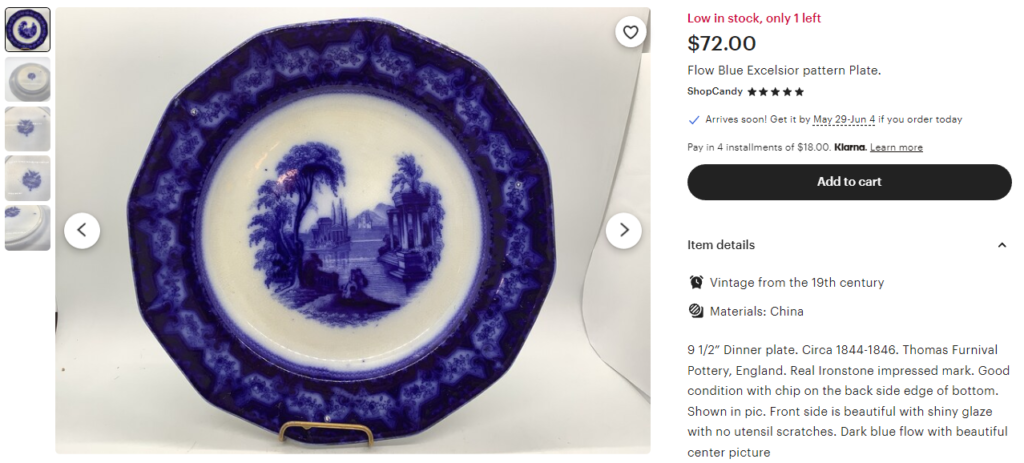
5. “Gothic” by Jacob Furnival & Co. (1860s)
Design: A tall Gothic cathedral on the left side and trees on the right side of the pattern.
Estimated Value: Gothic is a rare Flow Blue china pattern, making it valuable. A small, 7-inch JF & Co. single plate with the Gothic design sold for almost $40 on eBay.
6. “Kyber” by W. Adams (1870s)
Design: A highly-detailed traditional Oriental landscape featuring palm trees, temples (Pagodas), human figures, and flowers with foliage.
Estimated Value: Flow Blue Kyber china is highly valued by collectors, fetching up to $100 to $150 for single dishes. A rare, 12-inch platter with Kyber pattern sold for a whopping $157 recently in an eBay auction.
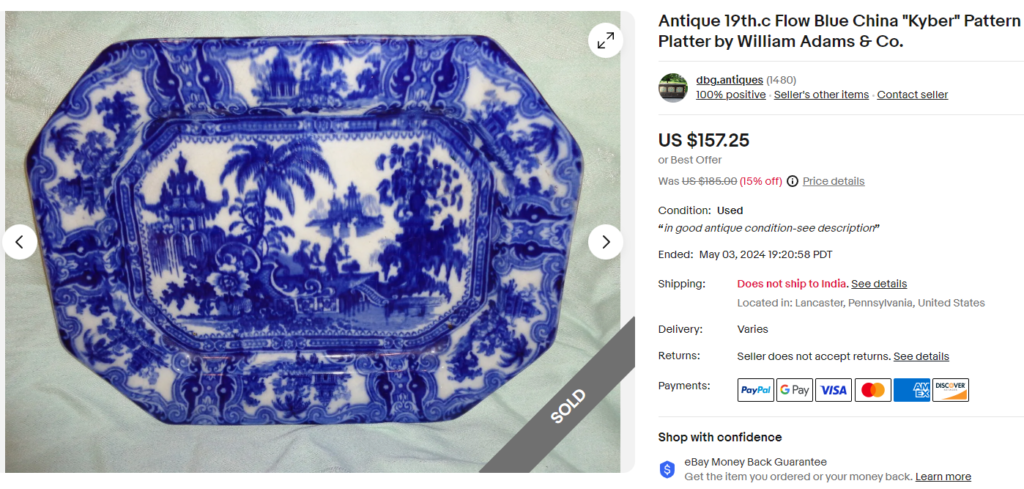
7. “Jardinière” by Utzschneider & Cie Sarreguemines Faience (1870s)
Design: A detailed Oriental-style pattern featuring delicate flower motifs with dense foliage at the center and at the edges.
Estimated Value: In good condition, single Sarreguemines china dishes like plates with the “Jardinière” pattern can sell for up to $40!
8. “Constance” by William A. Adderley (1875)
Design: Sleek and simple floral and foliage motifs on the edge with an empty center.
Estimated Value: A rare Flow Blue china pattern to find, single “Constance” plates and platters in pristine condition can sell for $30 to $40, like this one sold for over $44.
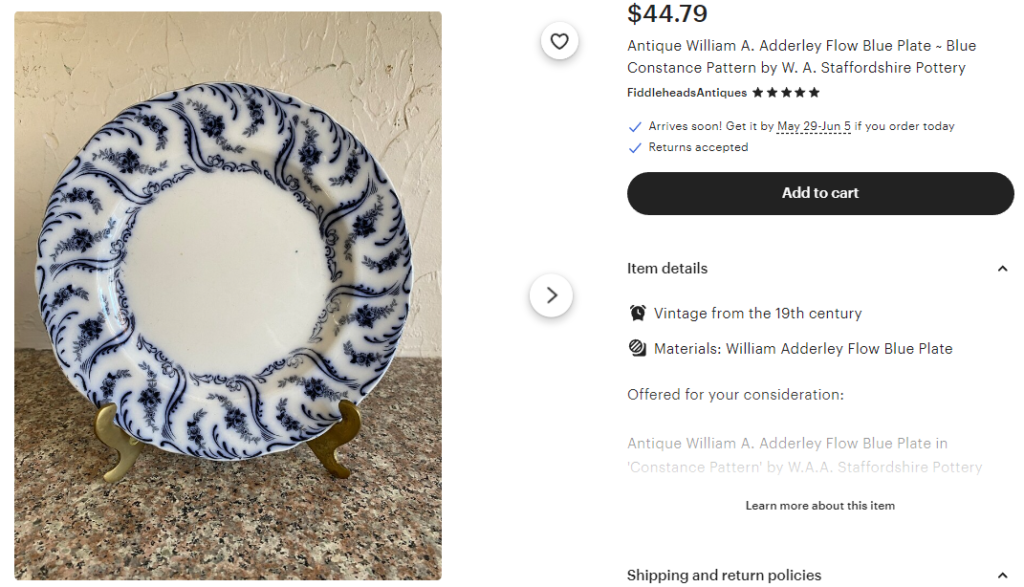
9. “Cow” by Wedgwood (1890s)
Design: A landscape at the center featuring multiple cows grazing and standing in a pond and trees and a village in the background and scrolls with the landscape on the edges.
Estimated Value: Wedgwood’s Cow Flow Blue china pattern is extremely valuable, worth up to $300 to $400 for individual pieces. I found a 17-inch Flow China dessert plate with the Cow pattern that sold for a whopping $275 on eBay!
10. “Kelvin” by Alfred Meakin (1891)
Design: It features detailed but soft floral scrolls in a deep blue color. The pottery has embossed designs with a gilded touch and scalloped designs on the rims.
Estimated Value: An 18-inch wide gilded Kelvin meat platter by Alfred Meakin sold for a high price of $165. Another example is a lidded serving bowl that sold for almost $90 on eBay!
11. “Argyle” by W.H. Grindley (1896)
Design: A swirly, spiraling paisley design on the edges with an empty center.
Estimated Value: W.H. Grindley’s Argyle is one the most collectible and highly sought-after Flow Blue china patterns and can be worth up to $200 to $400. I found a 17″ oval Argyle platter on eBay that sold for almost $240. Another example is a small Argyle pastry tray that sold for $200.
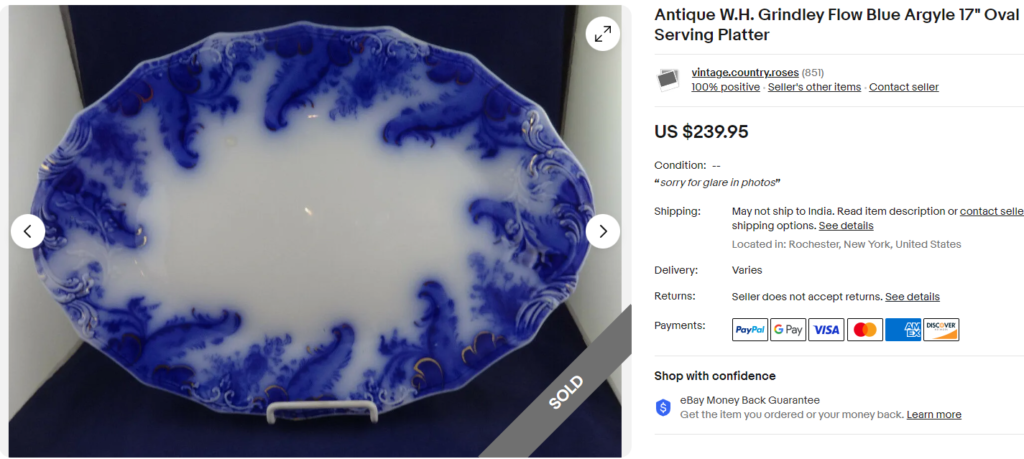
12. “Waldorf” by New Wharf Pottery (1892)
Design: A delicate floral and foliage design at the center and edges, attached to a blue rim.
Estimated Value: The resale price of single Waldorf Flow Blue china dishes ranges from $20 to $70, while the sets can go up to $200 or more, depending on the number of items.
13. “La Belle” by Wheeling Pottery (1900)
Design: Small and delicate hand-painted floral details with blue glaze pigment bleeding from the edges and a touch of gold.
Estimated Value: A Flow blue china platter with the La Belle pattern sold for $120, and a pair of a La Belle creamer and a sugar bowl sold for almost $300 on eBay.
14. “Weatherby” by Welbeck J.H.W. & Sons (1905)
Design: A detailed design in dark navy blue (steel blue) pigment featuring poppies enclosed with a scroll pattern including heart, flowers, and foliage motifs.
Estimated Value: A newer but rarer design to find, the Weatherby Flow Blue china dishes can fetch good returns. A large, 16-inch Welback meat tray with the Weatherby pattern sold for a stunning price of $117 on Etsy.
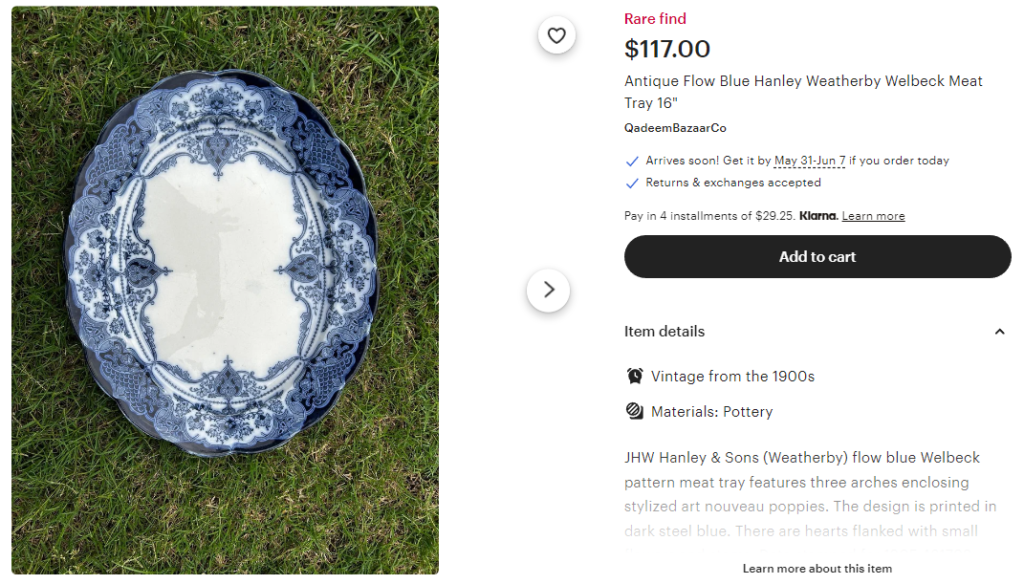
Flow Blue China Markings
The maker’s marks at the bottom of Flow Blue China are another important key to identifying it. Many Flow Blue pieces display a printed underglaze mark or stamp of their manufacturer. Some may also bear the name of the pattern or some sort of date code.
Based on the company’s stamps, you can look up online auction sites to see the average worth of your piece and its rarity. However, there may not be any specific markings to verify the Flow Blue patterns.
In conclusion, Flow Blue china is a precious antique, thanks to its unique “flowing” design that instantly catches collectors’ eyes. So, if you have a vintage china item with a blue and white pattern on it, identify and value it using this handy guide. Who knows? You might own a collective Flow Blue China, a Blue Willow China, or a Gzhel Pottery piece worth hundreds of dollars!
Note: This article is intended for informational, educational, and entertainment purposes only. Some images are illustrative and may not represent actual brands, products, or related entities. All trademarks, product names, brand logos, packaging, and other intellectual property referenced remain the exclusive property of their respective owners. Any brand mentions or references are provided solely for descriptive and educational context and do not imply any formal or commercial association.

